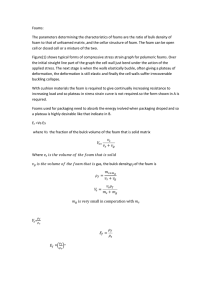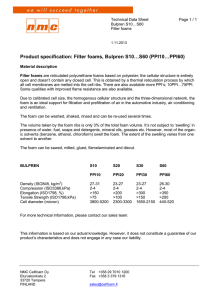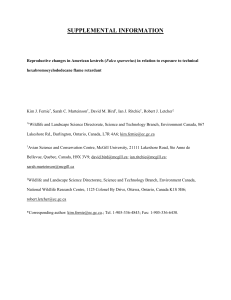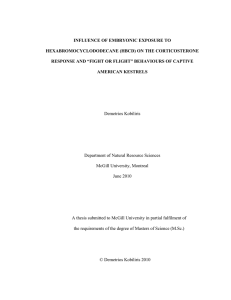HBCD in Polystyrene Foams: Product Safety Assessment
advertisement
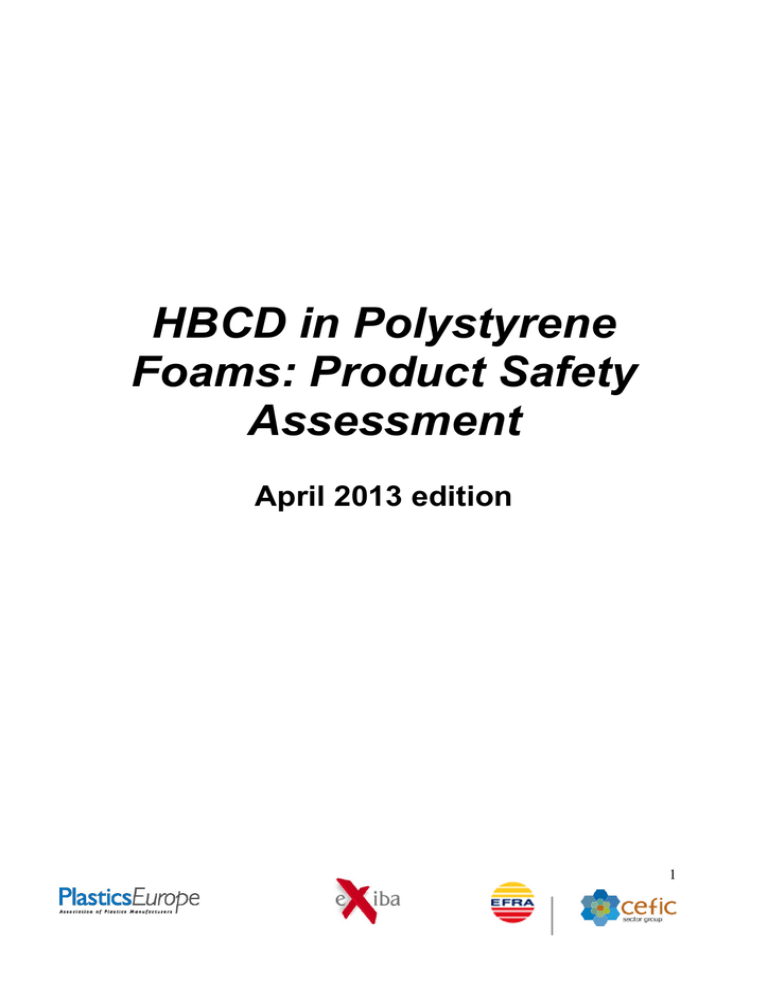
HBCD in Polystyrene Foams: Product Safety Assessment April 2013 edition 1 | The information, analysis, methods and recommendations herein are presented in good faith, are believed to be accurate and reliable, but may well be incomplete and/or not applicable to all conditions or situations that may be encountered. No representation, guarantee or warranty is made as to the accuracy, reliability or completeness of this report, or that the application or use of any of the information, analysis, methods and recommendations herein will avoid, reduce or ameliorate hazards, accidents, losses, damages or injury of any kind to persons or property. 1. SUMMARY Polystyrene Foams are useful polymers for a variety of insulating applications in buildings and in uses related to civil engineering where fire safety has to be considered. These polymers contain small amounts of HBCD. Considerations about product safety for such materials are therefore also related to the question to which extent such additives may pose any health and environmental risks during handling, use and disposal. The aim of this document is to provide the general basis for safety assessment of polystyrene foam products and to demonstrate it for the exposure scenario insulation foam The document provides background information demonstrating that polystyrene foams containing HBCD, when properly handled in-use and disposed, do not represent a risk neither to man nor to the environment. The flame retardant HBCD is retained in the polystyrene foam matrix, thus preventing migration and exposure via surface contact. Worse case exposure scenarios have been investigated. Together with toxicity testing to aquatic organisms, proof is delivered that there is neither adverse effect nor exposure and hence no risk to man and to the environment have to be expected. It is concluded that in the exposure scenarios described, no adverse health and environmental effect is anticipated from the use and disposal of polystyrene insulation foams. It is possible to perform product safety evaluations for any other polystyrene foam product, on a case by case basis, using a similar approach. 2. INTRODUCTION HBCD is used in EPS and XPS foams in a variety of insulating applications in buildings and in uses related to civil engineering where fire safety has to be considered. The main applications in buildings include roofs, internal and external walls, floors and perimeters. For civil engineering applications, XPS is used mainly under railways and roads. During service life, the foams might be exposed to air, water and soil. Therefore, the potential release of HBCD during 2 | service life of EPS and XPS used in applications representing worst case scenarios has been assessed. The following applications were identified: ● Walls: exposure to air and light: ● Inverted roof, cellar, perimeter, railways and under road: exposure to (rain) water ● Cellar, railways and under road: exposure to soil In order to assess the exposure the following worst case scenarios have been selected within the above identified applications: a) Exposure to light (degradation): External wall and façade Under typical applications the foam is not exposed to light since the foam is covered with a facing or layer so that light is not able to access. Only in the case of agricultural building the foam is exposed on the walls however in this case there is limited light access. In external walls and facades the foam is covered. Generally, in Europe the foam is used quickly meaning that it is normally not stored for long periods of time outside before construction which limits access to light. b) Exposure to water: Inverted roof. At this stage only exposure to rain water was assessed. 3. EXPOSURE ASSESSMENT a) Exposure to light (degradation) –External wall and façade As mentioned above, generally, in Europe the PS foam is used quickly before construction and is correspondingly not stored for long periods of time outside which limits access to light. . Consideration is therefore only given to the following applications: For External walls: When EPS or XPS foam containing HBCD is used in construction, the foam is covered in all applications except when used in agricultural buildings. Experience from long-term results (up to 32 years service life) indicates that the foam is durable during service life when the foam is covered according to the technical rules. The conclusion is that no decomposition of foam is expected after prolonged service life when it is covered in the application, which indicates that it can reasonably be expected that HBCD remains retained within the stable polymer matrix. 3 | For Uncovered XPS specimen: Measurements of bromine content have been made in XPS foam specimens for a period of approximately 19 years. The specimens were cubes of approximately 8 cm3 volume with an HBCD content in the range of 0.3% to 5.8%. The cubes were stored in natural light and under standard laboratory conditions with respect to temperature and humidity. Total bromine content was measured in 1987/8 using the neutron activation method and in 2007 using X-ray fluorescence. According to this measurement it could be concluded that levels of HBCD remained stable in all the cubes for a period of approximately 19 years. The conclusion is that no loss of HBCD is expected to occur in the foam during service life, even when exposed to natural light. Hence the demonstration that HBCD is retained in a stable polymer matrix during service life. b) Exposure to water – Inverted roof The Inverted roof (upside-down roof) is considered to be the worst-case application scenario for potential emissions of HBCD to water. This is because there is direct contact with water in the form of rain, and the water run-off may lead to exposure to the environment via drains and directly to the soil compartment. An examination of an XPS foam board from an inverted roof (25 years service life) has been made by measurements of the bromine level in samples taken in different points across the board. Total bromine content was measured and compared to the original levels detected immediately after the production of the foam. The original concentration of HBCD in 1982 was 0.61%. In 2007, concentrations across the foam were between 0.59% and 0.62%, with an average of 0.61%. The standard deviation for the total 12 analyses was 0.01%. This study shows that the HBCD was equally distributed in the foam and the levels remain at a similar level (within the experimental error of 0.01%) compared to the initial levels. The conclusion is that HBCD is not likely to be released into the rain water during service life of XPS foam boards, even when considering the worst case scenario of inverted roof. Hence the demonstration that HBCD is retained in a stable polymer matrix during service life. c) Emissions to air: emission test chamber experiment The emission test chamber experiment can, similarly to the inverted roof case, be considered to be the worst-case scenario for potential emissions of HBCD to, in this case, the (indoor) air compartment. This is because of the relatively small volume of the test chamber and the high air exchange rate (see for more details below). 4 | Polystyrene boards with an emitting surface of 0.931 m2 were incubated in an emission test chamber with a volume of 200 L and an air exchange rate of 0.4 m3 / h for 90 days at room temperature. The air was directed through glass wool adsorber for 42 and 48 days, respectively (total duration 90 days) and the latter extracted with dichloromethane. For both collection periods no HBCD could be found in the dichloromethane extract (limit of quantification 20 ng/m3). The conclusion is that HBCD is not likely to be emitted into the surrounding air during service life of PS foam boards. Hence also this experimental setup demonstrates that HBCD is retained in a stable polymer matrix during service life. The same conclusion can be drawn from the modeling approach discussed further below in Chapter 5 of this document. 4. HAZARD/TOXICITY ASSESSMENT The conclusions reached in the assessment of possible releases of HBCD during service life of EPS and XPS foams under worst case conditions have been confirmed in a series of biotests conducted for the evaluation of environmental waste classification of EPS and XPS foam boards containing Hexabromocyclododecane as flame retardant. The Water Accommodated Fractions (WAFs) of extruded and expanded polystyrene materials (XPS and EPS), containing up to ca. 2% Hexabromocyclododecane (HBCD) as flame retardant, were experimentally tested for possible acute aquatic toxicity. As test organisms the green alga Desmodesmus subspicatus (Method C.3 Commission Directive 92/69/EEC (SafePharm Laboratories, Project number: 2631/0002 and2631/0004, unpublished studies, 2008) and Daphnia magna (Method C.2 Commission Directive 92/69/EEC (SafePharm Laboratories, Project number: 2631/0001 and 2631/0003, unpublished studies, 2008) were used. The test organisms, conditions and procedure were based on UK Environmental Agency Technical Guidance Document WM2 (Hazardous Waste; Interpretation of the Definition and Classification of Hazardous Waste – Appendix C: C14-H14 Ecotoxicity) amended 2006. This allows for testing to prove whether a hazardous property is present or not. Corresponding to this procedure a Water Accommodated Fraction (WAF) was generated by stirring samples of the test materials (foam cubes of XPS and EPS) for 48 hours in the test medium at 20 °C corresponding to an initial loading rate of 100 mg/l. The test organisms were then exposed to the aqueous eluent of the test material without further dilution (limit test). After 48 and 72 hours exposure, no adverse effects on Daphnia mobility/mortality and algae growth, respectively, were observed at a loading 5 | rate of 100 mg/l for both XPS and EPS foam tested. No corresponding chemical analysis was performed. These results confirm the findings of previous studies. In one of these studies flame retarded EPS, in the form of beads, was tested at a loading rate of 100 mg/l for acute toxicity towards daphnids and freshwater algae, using an even longer period of elution. Also in those studies no lethality in daphnids or growth inhibition in algae was observed. In another series of tests with 20 hours WAFs of XPS and EPS foams with up to 2 % HBCD no adverse effects on the growth of the marine alga Skeletonema costatum was observed. The conclusion is that on the basis of the conducted studies, waste EPS or XPS foam boards do not need to be classified as hazardous waste. 5. EMISSION MODELLING The conclusions reached in the assessment of possible releases of HBCD during service life of EPS and XPS foams under worst case conditions have been further confirmed in an emission modeling investigation. In 2012 a study on the simulation of specific air emissions of HBCD from EPS/ XPS foams was undertaken. Based on a generally recognized diffusion model cumulative emissions to the air compartment during the long-term use of HBCD containing PS insulation board could be made. Based on an assumed diffusion behavior of HBCD in Polystyrene for an EPS/ XPS insulating panel with an estimated service time of 100 years a cumulated total emission of 175 µg /m2 HBCD after 100 years at 230C would result if no boundary resistance at the surface exists i.e. HBCD evaporates readily to air. In other words due to the very low diffusion rate of HBCD in PS it would take approximately 100 years to deplete 0.1 µm of the PS skin layer of the EPS/XPS insulating panel. If a slower evaporation rate compared to the diffusion rate would apply as boundary resistance at the foam/ air interface the HBCD emission would be even lower. 6. CONCLUSION On the basis of the available data and the application of conservative assumptions, for the scenario of insulation of a polystyrene foam, no adverse health and environmental effects are anticipated as a result of the use of HBCD containing PS foams since it could be demonstrated in a number of independent studies that HBCD is immobilized within the PS matrix and as such is not released into the environment. 6 |
